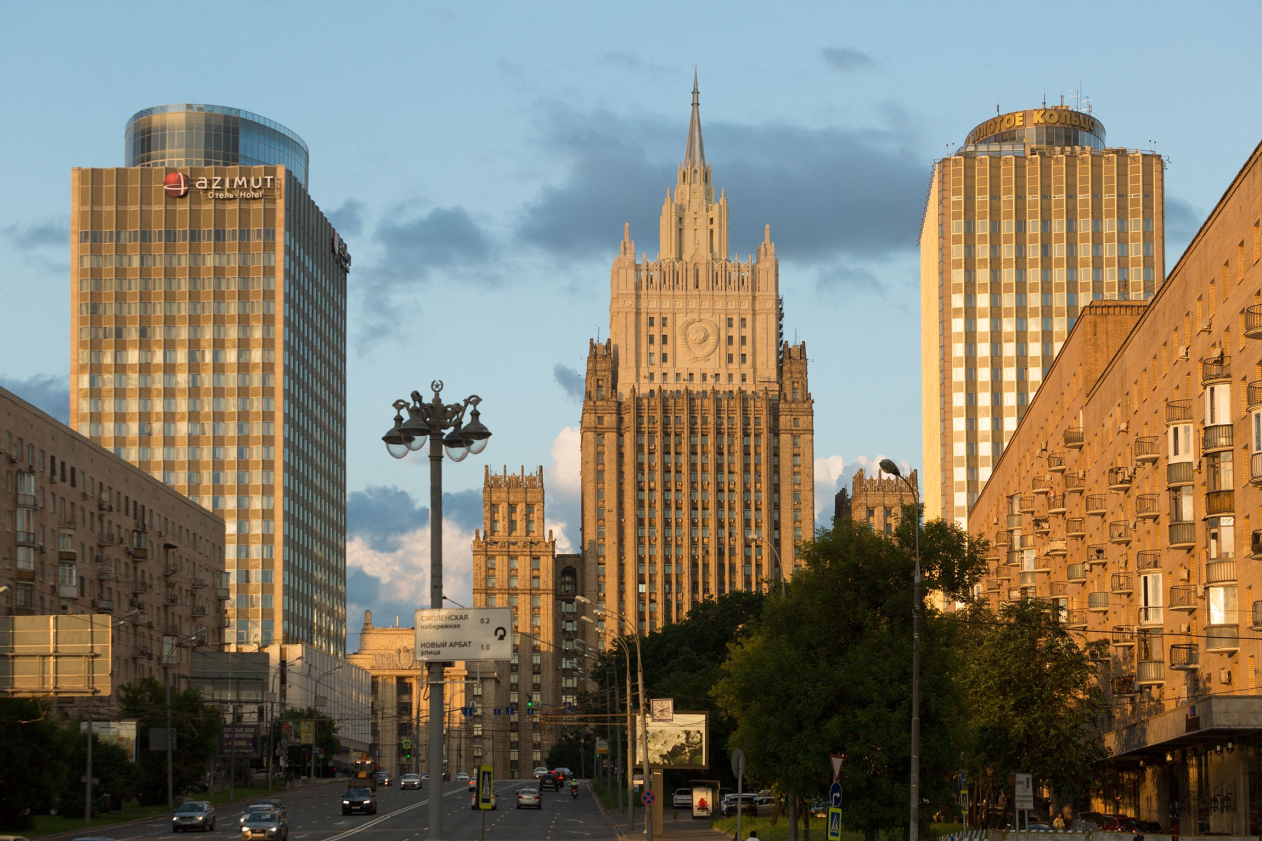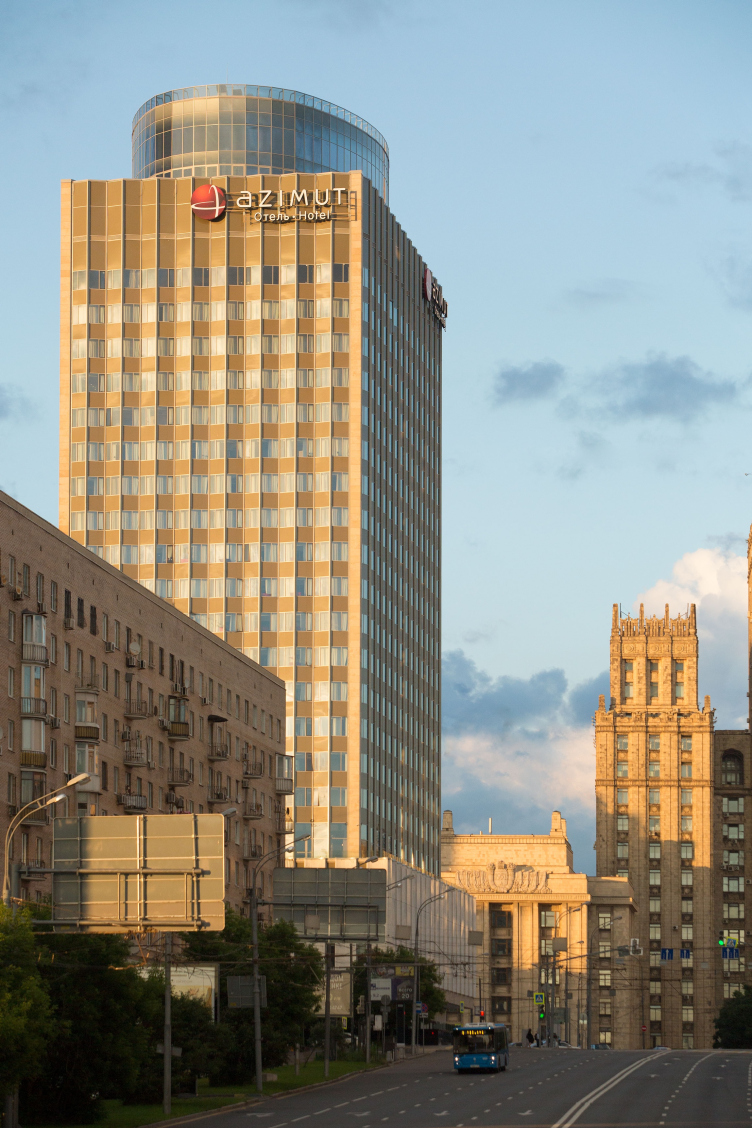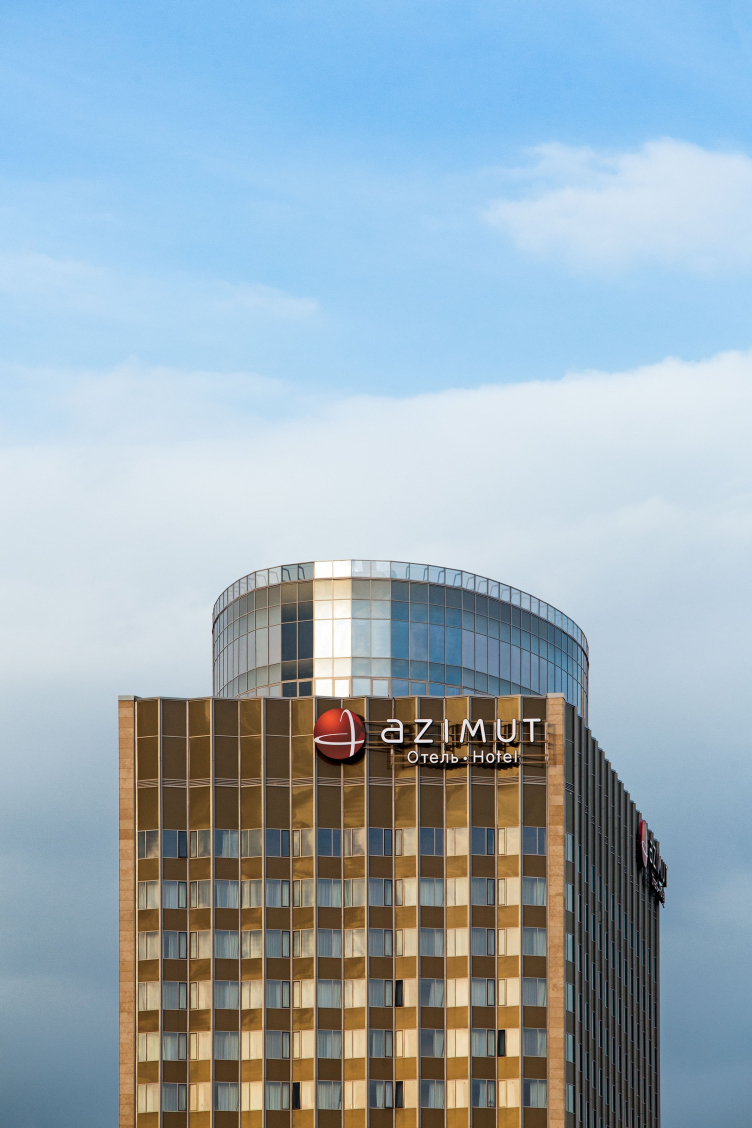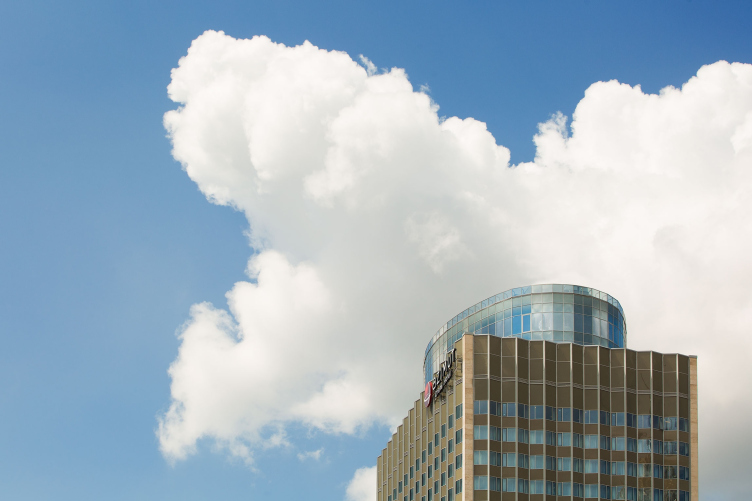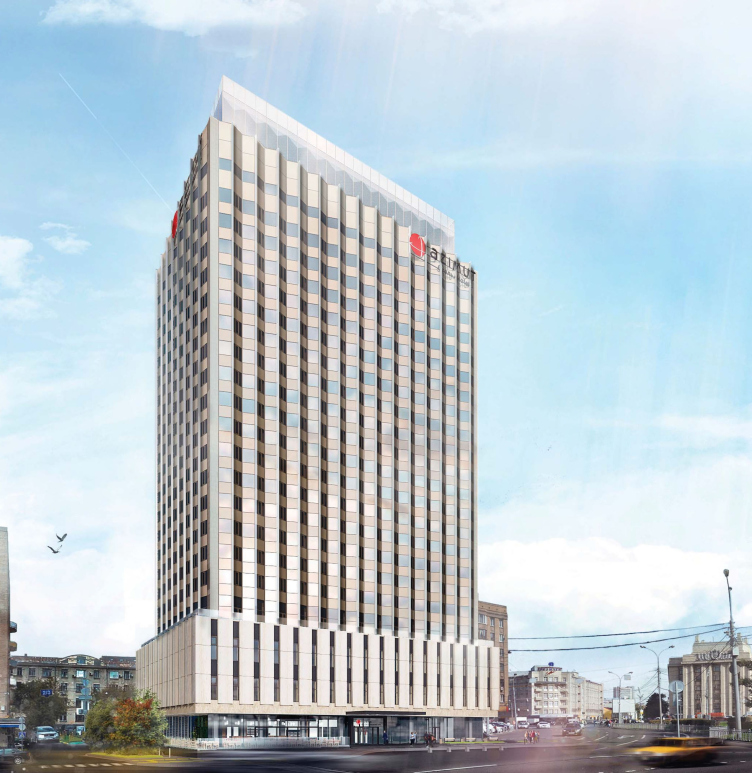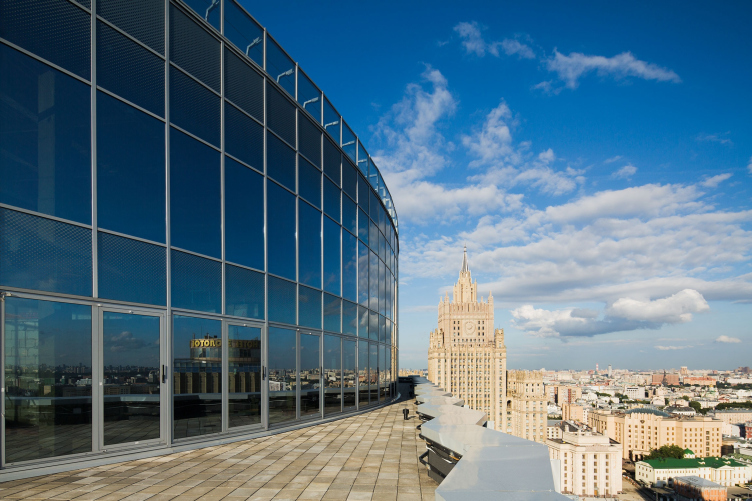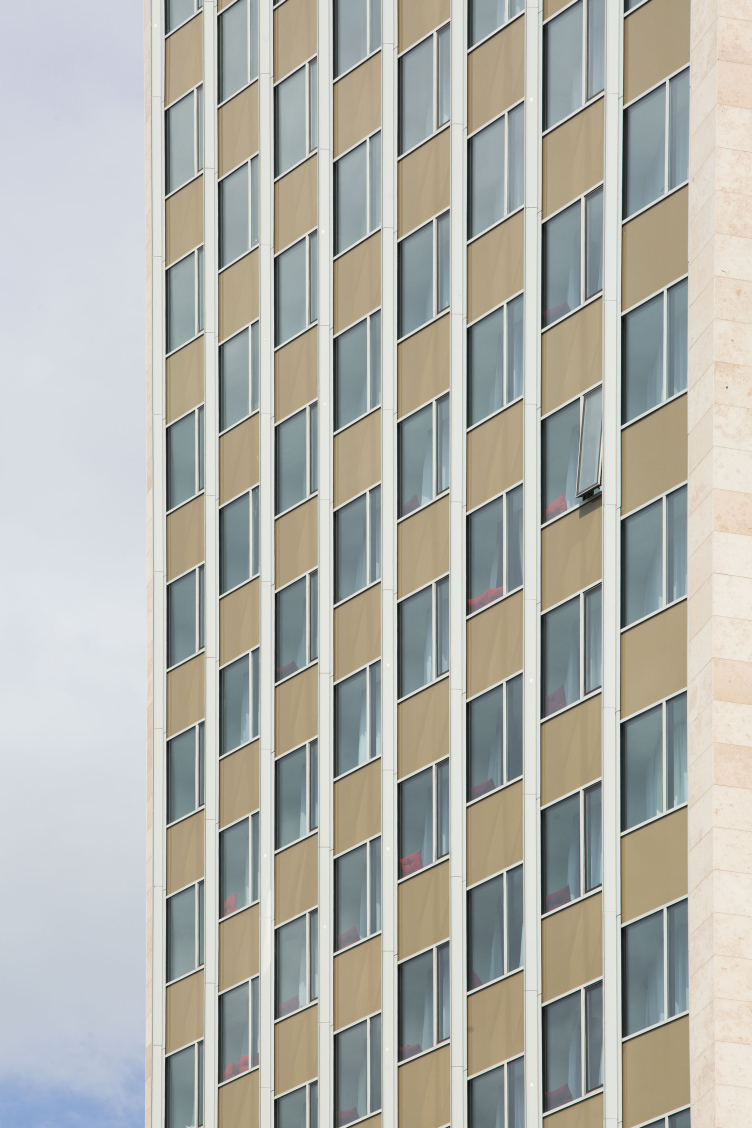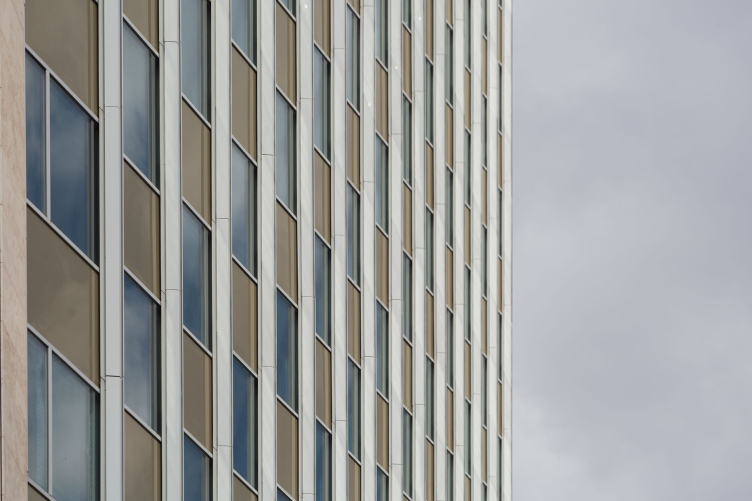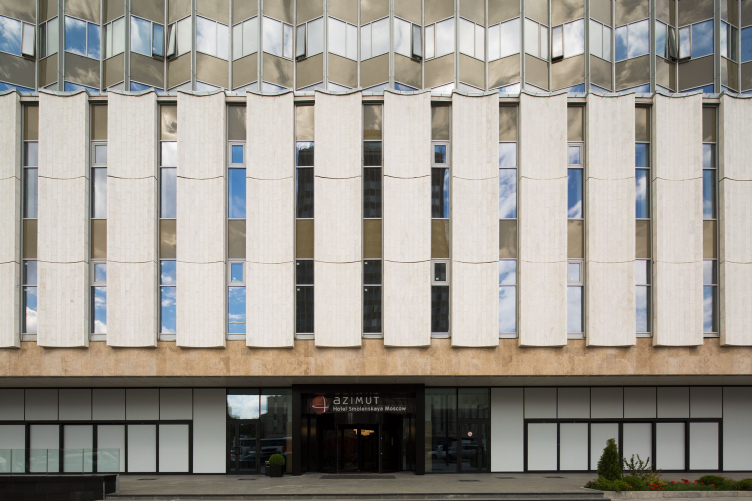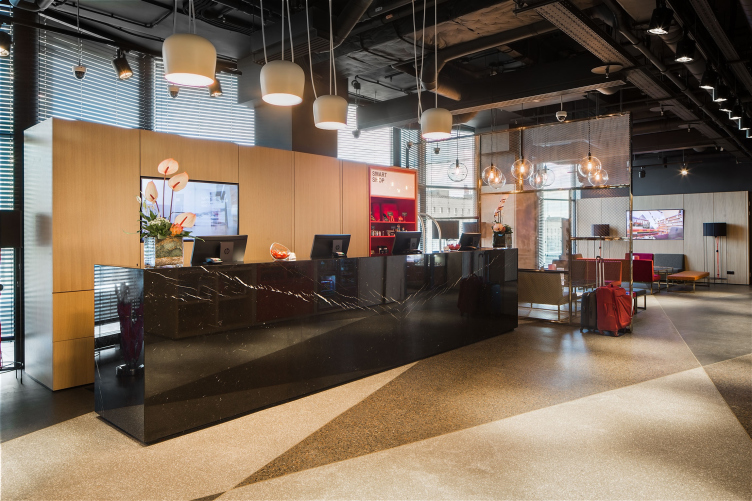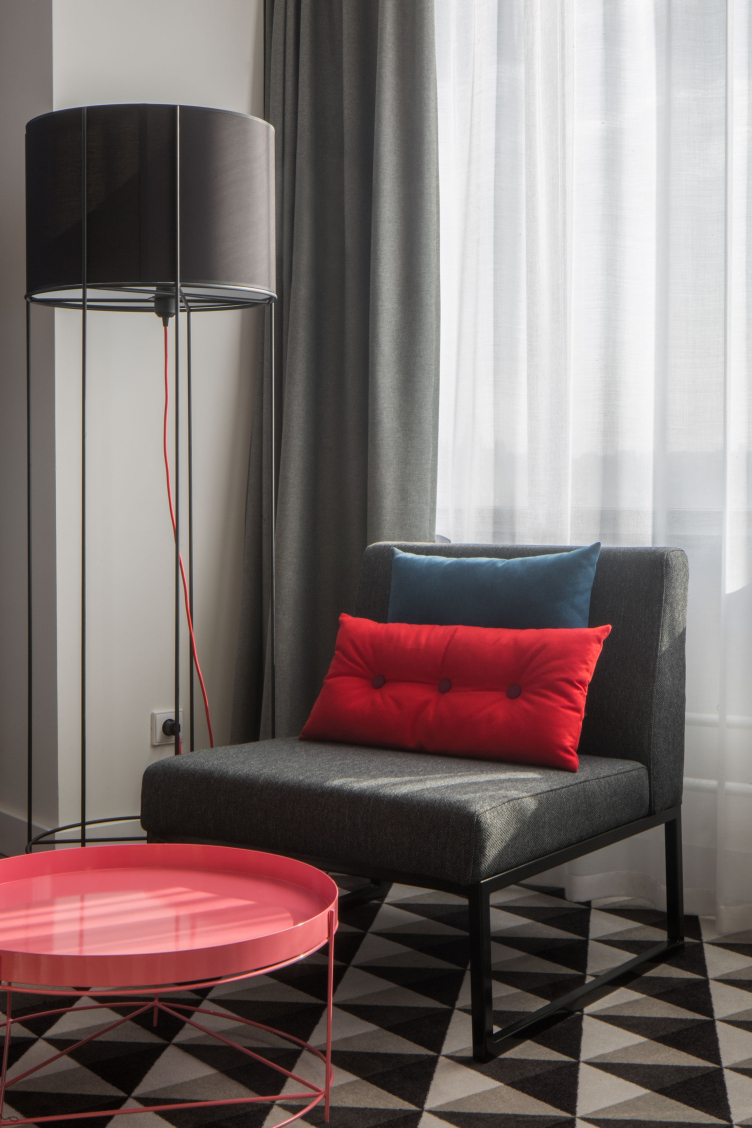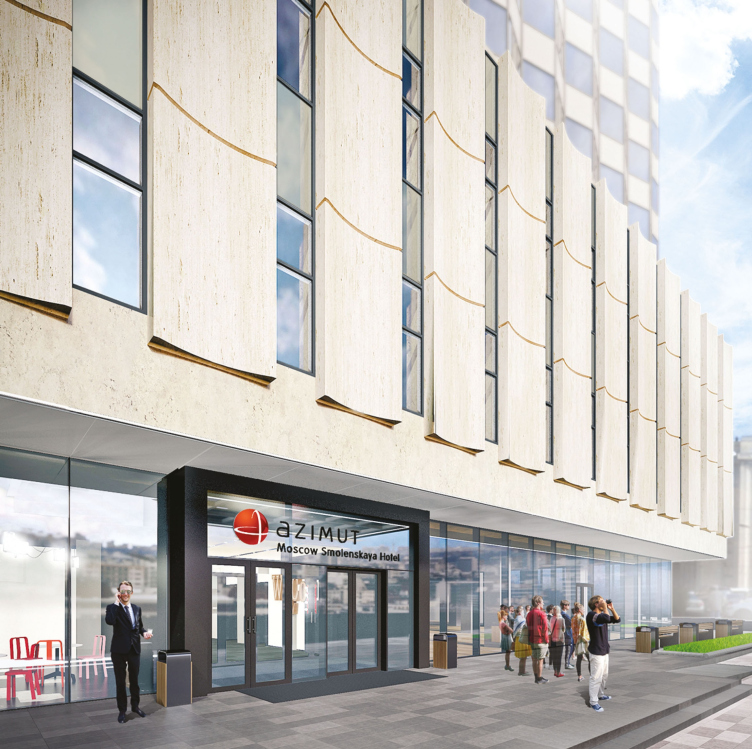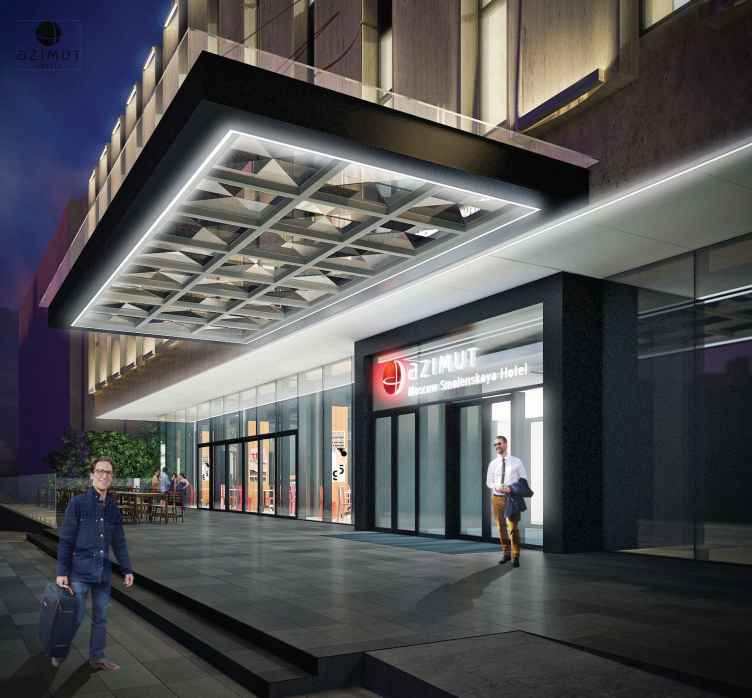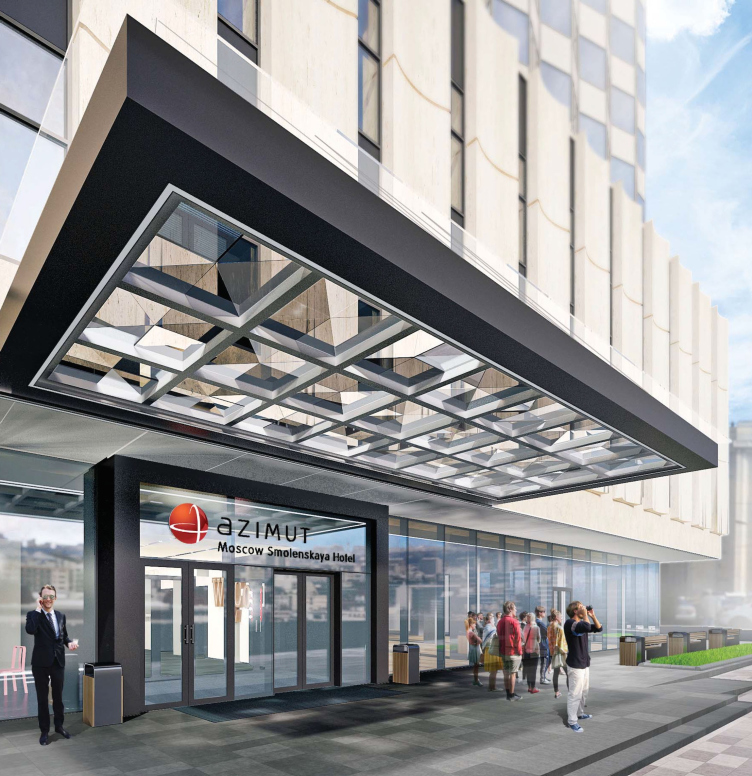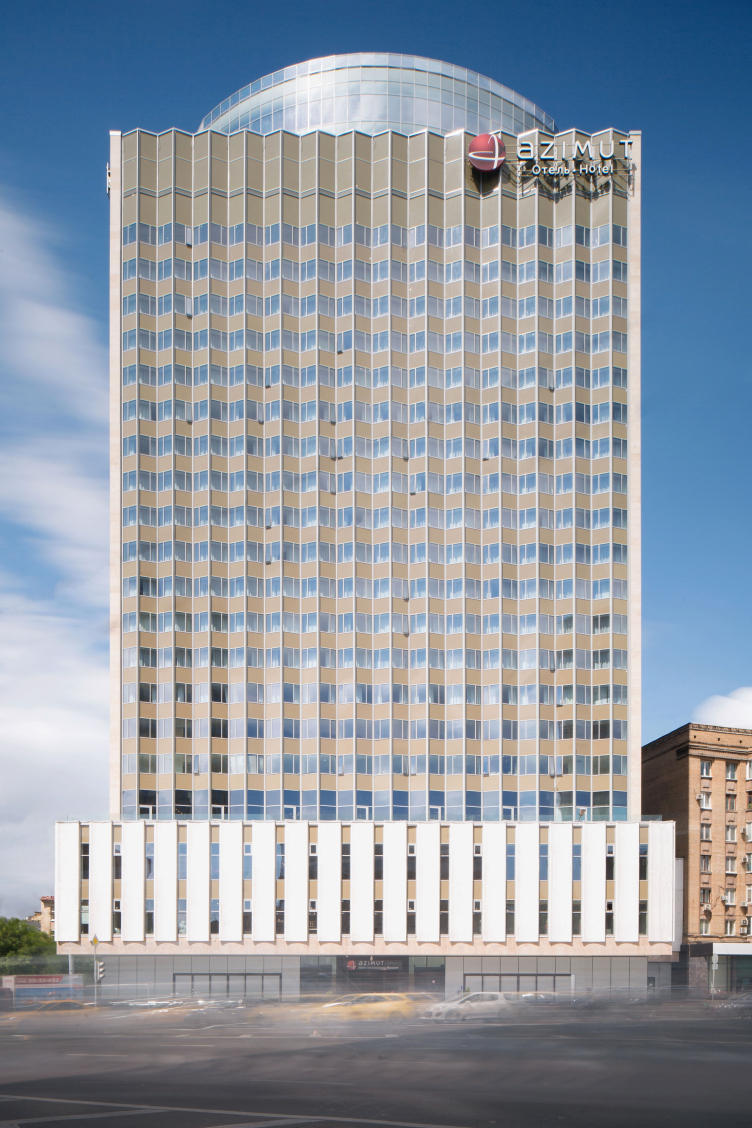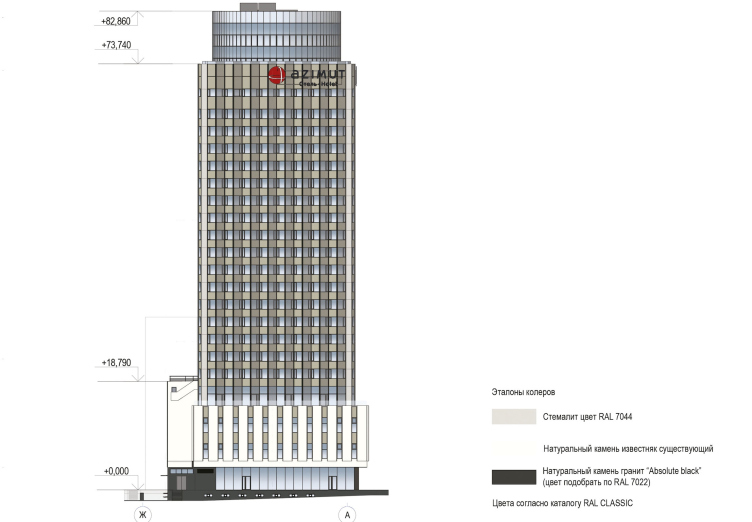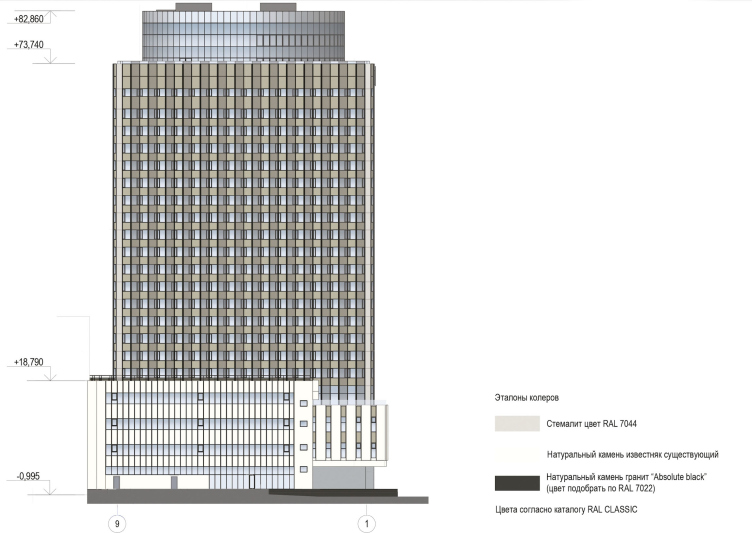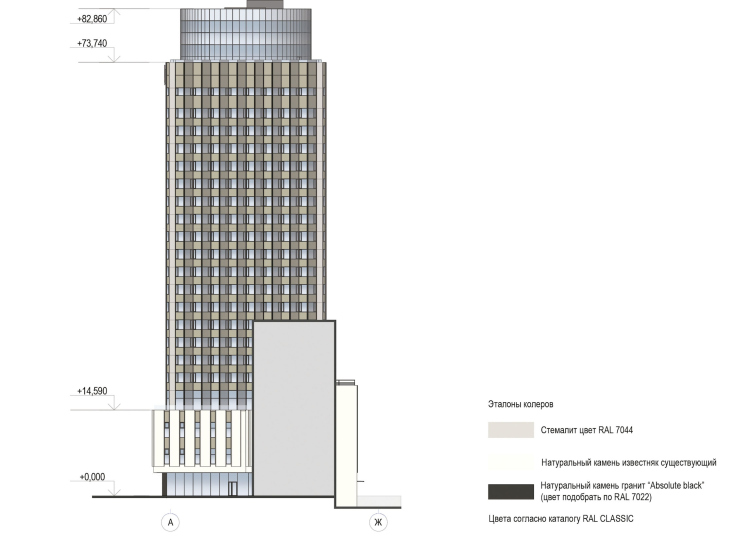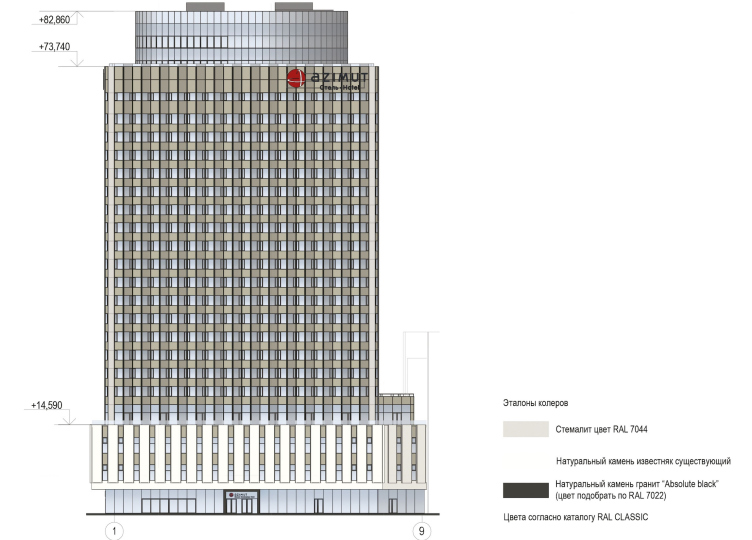It seems that only recently we witnessed the “grand closing ceremony” of the Belgrade Hotel that hailed the start of its refurbishment and reconstruction, and – behold – the Azimuth Hotel Smolenskaya is receiving its first wave of guests. The authors of the reconstruction project, Т+Т Architects, are generally satisfied with both the work tempo and the end result.
Azimut Hotel Smolenskaya © T+T Architects
Azimut Hotel Smolenskaya
Copyright: © T+T architects
To start with, we will remind you that Belgrade, or, rather, Belgrade-1 is in fact part of the architectural ensemble of the Smolenskaya Square and is one of the twin towers built in the 1970’s by the architects Vladimir Gelfreich, Vitaly Sokolov, and Alexander Kuzmin. Vladimir Gelfreich was also one of the authors of the Ministry of Foreign Affairs building, which is essentially a centerpiece and a conceptual dominant of the whole square; he was also the chief architect of the entire architectural ensemble. After a few decades of Belgrade flourishing as one of the most prestigious soviet hotels – and, of course, the haunt of the Moscow black marketeers and under-the-counter traders – the power in this country changed, and, paradoxically though this may sound, the towers went their separate ways. First, the younger one got lucky – Belgrade-2 was reconstructed to become the “Golden Ring” hotel. Over the last twenty years, there were two attempts of renovating Belgrade, and the second one was left incomplete: by the time the building was bought out by the Azimut Hotels chain, only half of its floors were functioning (“half” being a pretty optimistic estimate), the others stood under-remodeled, but, curiously enough, its top floor was fully occupied by the owner’s family.
Azimut Hotel Smolenskaya © T+T Architects
Out of the four versions of the reconstruction project submitted by Т+Т Architects, the client chose the one that brought the appearance of the building as close as possible to the original, the way it was designed by Gelfreich and his coauthors. Still, there was one exception to be made, though – in order to revive the feeling of the architectural ensemble, and, to a large degree, for business reasons (it would be a waste to lose such a unique vantage point upon the roof!), it was decided that the roof (just as in the case of “Golden Ring”) will get a buildup of a restaurant. That was the only tribute that the architects paid to the building across the road – neither the architectural details of questionable value, such as the “crown” displaying the hotel name at the top edge, nor the counterintuitive color design solution were considered to be worth paying any special respect to. The elevation marks of both hotels are practically on a level but Azimuth’s buildup has two floors in it, and at the expense of the floor-to-ceiling stained glass windows and the “skirts” of the cupolas it looks much more slender and elegant. The restaurant got some extra height thanks to the decorative screen that conceals the engineering equipment routed out on the roof.
Azimut Hotel Smolenskaya © T+T Architects
Azimut Hotel Smolenskaya © T+T Architects
Azimut Hotel Smolenskaya © T+T Architects
Initially, by the way, they wanted to give the buildup a rectangular shape – this form would better correspond to the tectonics of the building, and from the interior design standpoint the rectangular volume would be a lot easier to work with, too. Ultimately, however – again, out of the ensemble-factor reasons – the architects settled for an ellipse. But then again, a combination of such different shapes is quite in the spirit of the modernism of the 1970’s. Construction-wise, however, this created an extra task for the designers and builders: because of the vastly different floor plans, they had to make relieving platforms that cover the entire perimeter and transmit the load to the subjacent structures. But then again, the builders had to strengthen the building’s framework from top to bottom anyway, for the exception of the outside columns – even the foundation was slightly reinforced.
Project of renovating "Belgrade" Hotel © T+T Architects
Originally it was planned that the buildup would be totally executed from curvilinear glass – no metal profiles whatsoever, just pure form, a play of reflections dissolving in the sky. However, due to the fact that the glass making technology has not yet advanced to the point of making such a sophisticated structure as a single piece, ultimately the glass surface had to be divided into sections. A few more months were taken up by the search for the manufacturer that would be able to make 6-meter sliding stained glass windows – this was the requirement of the future tenant. Ultimately, the manufacturer was found in one of the European countries but the thermal performance of his product fell miles short of the Russian requirements for energy efficiency. Thus, instead of one broad passage, sliding along the radius, they ultimately got several narrow passages distributed by segments – also a compromise but quite an acceptable one.
Oh, and, by the way, about the tenant – during the reconstruction, his name was already known: this was the famous restaurant owner Boris Zarkov. Until the moment the restaurant on the Belgrade roof was built, his project named “White Rabbit” could arguably boast the best panoramic view in this area of the nation’s capital, and the “preemptive occupation” of the rivaling vantage point was a coup de maître strategic decision.
The restaurant is designed in such a way that both of its floors overlook the Kutuzovsky Avenue. The waterfront of the Moskva River, the Moscow City, and the Ukraine Hotel – the views are truly unique and magnificent here. And as far as the building of the Ministry of Foreign Affairs is concerned, it looks at its absolute best if viewed from the terrace – the architects provided for a one-and-a-half-meter tall triplex screen running along the perimeter – in addition to the obvious safety function, it will provide extra protection from the wind.
Azimut Hotel Smolenskaya © T+T Architects
As for the façades (whose geometry was not altered in any way in the course of reconstruction), the architects’ main task was to give the building its original appearance but with the use of today’s hi-tech materials. The aluminum, out of which the cross-beams were made, turned yellow over the forty years of the building’s lifetime but originally, of course, it was a gray metallic – and the architects tried to reproduce this shade of color. And, after that color had been nailed down, the architects tried to find the matching shade of the tinted glass covering the hanging concrete slabs: at first, they picked a few samples out of two dozens, and then they finally zeroed in on the right tone that was the perfect match with the insulated glass units. The latter wasn’t a walkover either: there were two competing manufacturers in the competition that went neck and neck down to the very finish line. Ultimately, both of them brought to the construction site two samples of glass units each, these were test-installed in combination with a few kinds of decorative tinted glass, and the result was evaluated in real-life conditions, from the north and the south side of the building. Ultimately, the architects settled for Asahi Glass: their glass is tinted from inside out, and the resulting shade is the closest of all to the old façades – a greenish tone that perfectly matches the beige tinted glass.
Azimut Hotel Smolenskaya © T+T Architects
Azimut Hotel Smolenskaya © T+T Architects
The only thing that is left of the original façades is the massive marble pylons which cover the second and third floors. What got replaced were only the corner parts where the stonework seemed to be falling apart. Here the architects were also in for a surprise, though: after the stonework was cleaned it changed its color from gray to sugar-white, and the color of the already assembled corners was obviously mismatched. The problem was ultimately solved by double water-repellent treatment. After it turns round the corner, the beige belt between the first and second floor runs to the annex of the management office (not really viewable from the avenue) coated with the same stone.
Azimut Hotel Smolenskaya © T+T Architects
The first floor was left fully glazed, its glass, unlike the glass of the main volume where a high level of sunlight protection is necessary, having the maximum transparency coefficient. The stained glass windows can now be pulled out – this is important for establishing a connection with the street outside because the whole first floor is occupied by bars and restaurants. At the client’s request, the reception area was raised up to the fourth floor, as well as the restaurant and the lobby bar.
Azimut Hotel Smolenskaya © T+T Architects
Higher, up to the 19th floor, there are hotel rooms; the 20th floor is occupied by a fitness zone, and the basement floor is occupied by a small parking garage. The main staircase, which in the original building was made with a shift for every four floors, is now fitted in a single stairwell, which looks good, and is both convenient and more practical in terms of safety.
Azimut Hotel Smolenskaya. Interior design © T+T Architects
Azimut Hotel Smolenskaya. Interior design © T+T Architects
As for the interior design of the hotel rooms, Т+Т Architects based themselves on the Azimut Hotels brand book – this global chain has hotels in Germany, Austria, as well as in some regions of Russia; in Moscow, Belgrade has become already a third hotel of this chain, and it is going to be marketed as the “flagship” of the three. The trademark color of the chain also defined the image of the entrance group that is highlighted with a massive black outline with the Azimut logo. The earlier versions of the project also provided for a faceted glass marquee, it even got some of the necessary approvals, but, since its tip crossed the red construction line, it, regretfully, had to be left out in the long run.
Project of renovating "Belgrade" Hotel. The entrance group without the marquee © T+T Architects
Project of renovating "Belgrade" Hotel. The entrance group with the marquee © T+T Architects
Project of renovating "Belgrade" Hotel. The entrance group with the marquee © T+T Architects
Thus, the ensemble of the Smolenskaya Square can be considered as restored. It is still far from perfect – the ex-“twins” are still pretty different but their meaning of the “propylaea” of the Smolenskaya Square is revived, the function of the hotel is also there, the façades of Belgrade-1 are carefully renovated and are sporting the characteristic elements of the architecture of the 1970’s. Just as it was designed by the authors of the original project, the towers accentuate and develop the silhouette of the Stalin high-rise of the Ministry of Foreign Affairs. And as for nuances and differences, they seem to be natural and inevitable in an urban environment anyway.
The publication of the drafts of the project is temporarily suspended at the client’s request.
Azimut Hotel Smolenskaya
Copyright: © T+T architects
Project of renovating "Belgrade" Hotel. Facade © T+T Architects
Project of renovating "Belgrade" Hotel. Facade © T+T Architects
Project of renovating "Belgrade" Hotel. Facade © T+T Architects
Project of renovating "Belgrade" Hotel. Facade © T+T Architects
